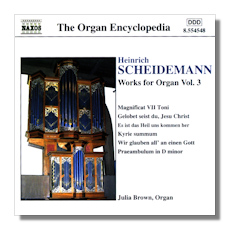
The Internet's Premier Classical Music Source
Related Links
- Latest Reviews
- More Reviews
-
By Composer
-
Collections
DVD & Blu-ray
Books
Concert Reviews
Articles/Interviews
Software
Audio
Search Amazon
Recommended Links
Site News
 CD Review
CD Review
Heinrich Scheidemann

Works for Organ, Volume 3
- Kyrie summum
- Es ist Heil uns kommen her
- Canzona for Organ in G Major
- Gelobet seist du, Jesu Christ
- Herzlich lieb hab ich dich, o Herr
- Magnificat im 7 Ton
- Jesu, du wolltest uns weisen
- Praeambulum for Organ #10 in F Major, WV 39
- Ego sum panis vivus
- Wir glauben all' an einen Gott
- Praeambulum for Organ #3 in D minor, WV 32
- Verbum caro factum est
- Praeambulum for Organ #7 in D minor, WV 36
- Jesus Christus unser Heiland II
- Gott sei gelobet und gebendeiet
- Vater unser im Himmelreich III
Julia Brown, organ
Naxos 8.554548
Heinrich Scheidemann was born around 1595, the son of an organist. In 1611 he traveled to Amsterdam to study for three years with Sweelinck. By 1625 he had succeeded his father at St. Catherine's Church in Hamburg, where he remained for the rest of his life, part of the seventeenth century renaissance in North German organ music. What we get on this highly recommendable Naxos recording is the third of a five part survey of Scheidemann's output for the instrument. If you enjoy the repertoire or want to explore a new area, you are advised to get this recording now (and the other remaining Volumes, 4 and 5) while it's still available: Volumes 1 and 2 have already fallen out of the catalog.
Volume 3 contains three Praeambula (forerunners of the Prelude and Fugue), the Magnificat VII Toni, chorale settings and examples of those overlooked but fine mainstays of seventeenth century organ genre, Intabulations, including 'fantasy'-style pieces with marked contrast between left and right hands. You'll be struck by just how plainly powerful, as opposed to intricate and massively contrapuntal, the music on this CD is. Scheidemann had a marvelous gift for melodic invention. Further, he was able to embellish and ornament his material to best effect, something which the clear and persuasive playing of Brazilian-born organist, Julia Brown, succeeds very well in conveying. She plays on a modern (1976) organ in Eugene, Oregon.
The influence of Sweelinck on Scheidemann is evident, though in such works as the most substantial items here on offer, Verbum caro factus est, Jesus Christus, unser Heiland, der von uns (II) and Gott sei gelobet und gebendeiet the former's excellence at polyphony supported by virtuosity have been transformed into something more spiritually rich and contemplative by Scheidemann. Listen to the way time almost stands still, yet with a full river of sound behind and ahead in the first of these three longer items, the Verbum caro, which is the most substantial piece on this CD. Such writing makes excellent use of the way in which north German organs of the seventeenth century offered solo treble and bass timbres simultaneously; in this case both equally florid, and played by Brown with almost dance-like lightness.
Indeed Brown is one with her instrument: she not so much guides us through the music, which would be to emphasize its structure at the expense of its beautiful sonorities, as opens a window on an almost magical world. Indeed, atmosphere is critical to all the music here. And a not overtly romanticized atmosphere at that. Yet the depth and perspective gently woven in sometimes breathtakingly long melodic lines does have an almost physical effect on the listener: these are not mere keyboard exercises, but creative expressions of Scheidemann's faith and talent. Brown's gift is to let the music nevertheless impose the discipline needed not only to move forward but also to serve the spiritual purposes which the composer was at pains to serve. This is first rate music made at the highest level. Buy it!
Copyright © 2007, Mark Sealey




















